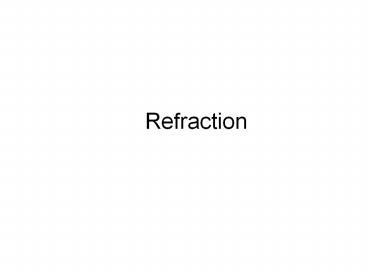Refraction - PowerPoint PPT Presentation
Title: Refraction
1
Refraction
2
Refraction
Refraction is the bending of light as it passes
from one medium into another.
N
Note the angle of incidence qA in air and the
angle of refraction qA in water are each measured
with the normal N.
The incident and refracted rays lie in the same
plane and are reversible.
3
Refraction Distorts Vision
The eye, believing that light travels in straight
lines, sees objects closer to the surface due to
refraction. Such distortions are common.
4
The Index of Refraction
The index of refraction for a material is the
ratio of the velocity of light in a vacuum (3 x
108 m/s) to the velocity through the material.
Examples Air n 1 glass n 1.5 Water n 1.33
5
Example 1. Light travels from air (n 1) into
glass, where its velocity reduces to only 2 x 108
m/s.What is the index of refraction for glass?
If the medium were water nW 1.33. Then you
should show that the velocity in water would be
reduced from c to 2.26 x 108 m/s.
6
Analogy for Refraction
3 x 108 m/s
2 x 108 m/s
vs lt vp
3 x 108 m/s
Light bends into glass then returns along
original path much as a rolling axle would when
encountering a strip of mud.
7
Deriving Snells Law
Consider two light rays. Velocities are v1 in
medium 1 and v2 in med. 2.
Segment R is common hypotenuse to two rgt.
triangles. Verify shown angles from geometry.
8
Snells Law
The ratio of the sine of the angle of incidence
q1 to the sine of the angle of refraction q2 is
equal to the ratio of the incident velocity v1 to
the refracted velocity v2 .
9
Example 2 A laser beam in a darkened room
strikes the surface of water at an angle of 300.
The velocity in water is 2.26 x 108 m/s. What is
the angle of refraction?
The incident angle is
qA
qA 900 300 600
qW 40.70
10
Snells Law and Refractive Index
Another form of Snells law can be derived from
the definition of the index of refraction
Snells law for velocities and indices
11
A Simplified Form of the Law
Since the indices of refraction for many common
substances are usually available, Snells law is
often written in the following manner
The product of the index of refraction and the
sine of the angle is the same in the refracted
medium as for the incident medium.
12
Example 3. Light travels through a block of
glass, then remerges into air. Find angle of
emergence for given information.
First find qG inside glass
qG
qG 30.70
From geometry, note angle qG same for next
interface.
13
Wavelength and Refraction
The energy of light is determined by the
frequency of the EM waves, which remains constant
as light passes into and out of a medium.
(Recall v fl.)
fA fG
lG lt lA
14
The Many Forms of Snells Law
Refraction is affected by the index of
refraction, the velocity, and the wavelength.
In general
Snells Law
All the ratios are equal. It is helpful to
recognize that only the index n differs in the
ratio order.
15
Example 4 A helium neon laser emits a beam of
wavelength 632 nm in air (nA 1). What is the
wavelength inside a slab of glass (nG 1.5)?
nG 1.5 lA 632 nm
Note that the light, if seen inside the glass,
would be blue. Of course it still appears red
because it returns to air before striking the eye.
16
Dispersion by a Prism
Dispersion is the separation of white light into
its various spectral components. The colors are
refracted at different angles due to the
different indexes of refraction.
17
Total Internal Reflection
When light passes at an angle from a medium of
higher index to one of lower index, the emerging
ray bends away from the normal.
When the angle reaches a certain maximum, it will
be reflected internally.
The critical angle qc is the limiting angle of
incidence in a denser medium that results in an
angle of refraction equal to 900.
i r
18
Example 5. Find the critical angle of incidence
from water to air.
For critical angle, qA 900
nA 1.0 nW 1.33
In general, for media where n1 lt n2 we find that
19
Summary
Refraction is affected by the index of
refraction, the velocity, and the wavelength. In
general
20
Summary (Cont.)
The critical angle qc is the limiting angle of
incidence in a denser medium that results in an
angle of refraction equal to 900.
21
Refraction Formulas
Total Internal Reflection
22
Diffraction Formulas
Youngs Experiment
Interference from a single slit of width a
23
Reflection Summary
The following equations apply equally well for
both converging and diverging mirrors.
24
Reflection Sign Convention
2. Image distance si is positive for real images
and negative for virtual images.
3. The focal length f and the radius of curvature
R is positive for converging mirrors and negative
for diverging mirrors.
4. The image height hi and the magnification M
of images is positive for erect images and
negative for inverted images.
25
Reflection Magnification
The magnification M of an image is the ratio of
the image size hi to the object size ho.
si is positive when real negative when virtual.
M is positive when image erect negative
inverted.































